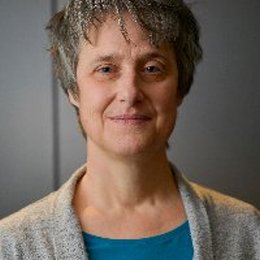All over the world, people enjoy living on the coast. The sea and beach are appealing locations, forming the basis for tourism as a key industry in the coastal economy. The coast, however, is always in motion, so we may wonder whether living by the sea is all that wise. Besides, how sustainable is it in the long term, with sea levels continuing to rise? University of Twente professor Kathelijne Wijnberg calls it ‘Living on the Edge’. She studies coasts and the processes that change them, using this knowledge to develop sustainable solutions for coastal problems. Nature and living on the coast can go hand in hand, if mankind gave nature a little more freedom. Professor Wijnberg gave her inaugural oration on 2 May 2019.
“Most people probably do not give it much thought, but in the west of the Netherlands, we live below sea level, which means we still rely tremendously on dunes to protect us from flooding. During storm tides, parts of our dunes can disappear into the sea. Typically, nature restores itself automatically, because the wind blows sand back to the dunes, where it clings to the beach grass. Now, though, we have built towns and cities atop our dunes, putting a halt to this dynamic natural process in places.” Professor Kathelijne Wijnberg is a researcher in Coastal Systems and Nature-based Engineering at the faculty of Engineering Technology. “We can continue to live by the sea, provided that we heed natural dynamics. The coast may have a touristic and economic function, but nature ultimately plays the lead role.”
The Sand Motor
A good example of natural processes cast in a starring role is the ‘Sand Motor’ project near The Hague, a man-made peninsula off the coast of Ter Heijde, in the middle of the Randstad, dating to 2011. Due to waves, currents and wind, this island will gradually disappear over the course of the next 20-25 years. A considerable portion of this sand is expected to be spread along the coast and blown into the dunes, securing the long-term effectiveness of the dunes as a form of flood defence. Normally, Rijkswaterstaat supplements sand carried away by sea currents by dumping sand on the beach and off the coast, keeping the coastline in place by means of this five-yearly sand replenishment. The Sand Motor concept, a worldwide first, is an attempt to make coastal maintenance more efficient, providing greater added value for recreation, the coastal economy and nature.
Cameras and sand
Since the construction of the Sand Motor, scientists, including Wijnberg, have studied what happens to this sand in practice, as well as its effects on flora, fauna and groundwater, in addition to examining whether the peninsula’s original design was as optimal as it could be. Together with PhD students, Wijnberg is studying what the wind does to the sand of the Sand Motor, exploring whether we can accurately predict its long-term effects on dune formation. Twelve cameras have been installed on the Sand Motor in order to monitor this process. Where does dune formation begin and how does sand transport occur? What role does moisture play and can we use mathematical models to predict the process?
Beach houses
Another aspect studied by Wijnberg and her PhD students is how beach use affects dune development. More and more beach houses, for instance, are being built right in front of dunes. Do they hamper dune formation, or can they make a positive contribution? How close should beach houses be to each other? “Perhaps we should look for a better way to get the sand behind the beach houses in order to stimulate dune formation. Or should we build houses on stilts?”
International
The Netherlands is not the only country that has to deal with these issues, which is why we also work with other countries, such as Brazil, Denmark and the UK, where the first Sand Motor outside the Netherlands is set to be built.
Outdoor person
People do not give much thought to the dangers of the sea and are often not aware of the coast-building capacity of the sea and the wind. As a physical geographer, however, professor Wijnberg has always been interested in landscape formation of coasts and rivers. “I was good at science at school, but I did not want to specialise in just one of all the various subjects. You use all sorts of science subjects in physical geography, but the degree programme is much broader and fieldwork is an important component. With Civil Engineering, I can put this broad knowledge to use to develop sustainable solutions for coastal problems. It allows me to combine my research at the university with field research, which is exactly what I want.”






